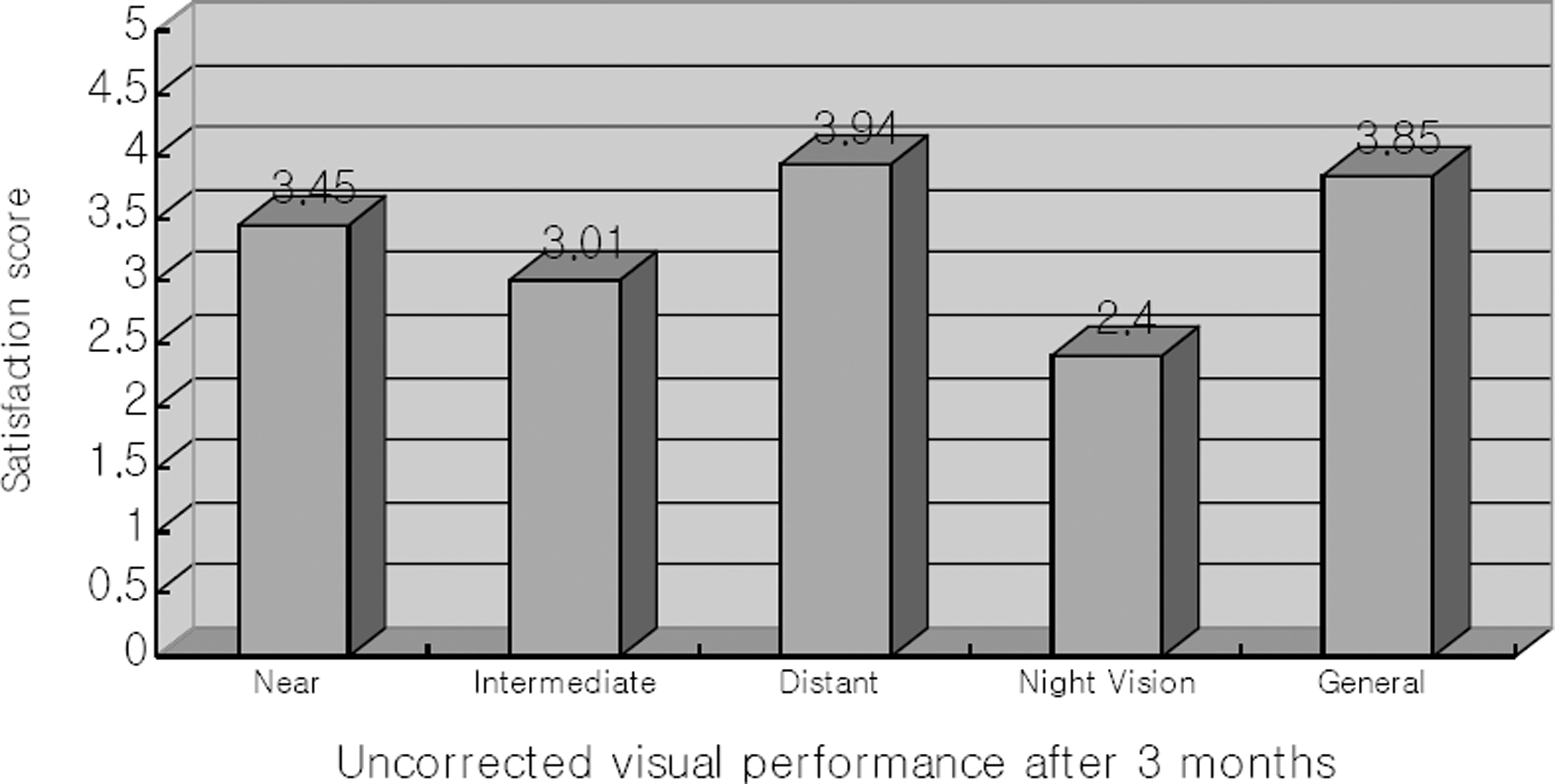Abstract
Purpose
To evaluate near and far visual outcomes, subjective visual symptoms, and patient satisfaction with AcrySof® ReSTOR® diffractive multifocal intraocular lenses (IOL), and to study the reasons for postoperative dissatisfaction.
Methods
Twenty-three eyes of 19 patients received phacoemulsifications and implantation of AcrySof® ReSTOR® IOL. The main outcome measures, taken at postoperative 1 day, 1 week, 1 month, and 3 months, were uncorrected and corrected near and distant visual acuity, refractory errors, subjective visual symptoms (glare, halo, and night vision), and satisfaction.
Results
At the 3-month postoperative visit, the mean uncorrected near and distant visual acuities were 0.59±0.24 (0.25±0.22 LogMAR unit) and 0.78±0.27 (0.13±0.10 LogMAR unit), respectively. In addition, patients’ satisfaction with uncorrected near vision, intermediate vision, far vision, and general visual performance were better than their satisfaction with night vision. Glare and halos were reported as severe by only 10.2% and 5.3% of patients, respectively.
The seven eyes with poor patient satisfaction included eyes with a high incidence of preoperative ocular diseases or preoperative and postoperative high corneal astigmatisms of more than 1.0 diopter.
References
1. Kohnen T, Allen D, Boureau C. . European multicenter study of the AcrySof ReSTOR apodized diffractive intraocular lens. Ophthalmology. 2006; 113:578–84.

2. Toto L, Falconio G, Vecchiarino L. . Visual performance and biocompatibility of 2 multifocal diffractive IOLs:six-month comparative study. J Cataract Refract Surg. 2007; 33:1419–25.
3. Alfonso JF, Fernández-Vega L, Baamonde MB, Montés-Micó R. Prospective visual evaluation of apodized diffractive intraocular lenses. J Cataract Refract Surg. 2007; 33:1235–43.

4. Blaylock JF, Si Z, Vickers C. Visual and refractive status at different focal distances after implantation of the ReSTOR multifocal intraocular lens. J Cataract Refract Surg. 2006; 32:1464–73.

5. Vander schueren I, Zeyen T, D'heer B. Multifocal IOL implantation: 16 cases. Br J Ophthalmol. 1991; 75:88–91.
6. Sen HN, Sarikkola AU, Uusitalo RJ, Laatikainen L. Quality of vision after AMO Array multifocal intraocular lens implantation. J Cataract Refract Surg. 2004; 30:2483–93.

7. Davison JA, Simpson MJ. History and development of the apodized diffractive intraocular lens. J Cataract Refract Surg. 2006; 32:849–58.

8. Slagsvold JE. 3M diffractive multifocal intraocular lens: eight year follow-up. J Cataract Refract Surg. 2000; 26:402–7.

9. Vingolo EM, Grenga P, Iacobelli L, Grenga R. Visual acuity and contrast sensitivity: AcrySof ReSTOR apodized diffractive versus AcrySof SA60AT monofocal intraocular lenses. J Cataract Refract Surg. 2007; 33:1244–7.

10. Tochel CM, Morton JS, Jay JL, Morrison JD. Relationship between visual field loss and contrast threshold elevation in glaucoma. BMC Ophthalmol. 2005; 13:22–8.

11. Gardiner AM, Armstrong RA, Dunne MC, Murray PI. Correlation between visual function and visual ability in patients with uveitis. Br J Ophthalmol. 2002; 86:993–6.

12. Ellemberg D, Lewis TL, Maurer D. . Spatial and temporal vision in patients treated for bilateral congenital cataracts. Vision Res. 1999; 39:3480–9.

13. Hayashi K, Hayashi H, Nakao F, Hayashi F. Influence of astigmatism on multifocal and monofocal intraocular lenses. Am J Ophthalmol. 2000; 130:477–82.

14. Chiam PJ, Chan JH, Aggarwal RK, Kasaby S. ReSTOR intraocular lens implantation in cataract surgery: quality of vision. J Cataract Refract Surg. 2006; 32:1459–63.

15. Randazzo A, Nizzola F, Rossetti L. . Pharmacological management of night vision disturbances after refractive surgery Results of a randomized clinical trial. J Cataract Refract Surg. 2005; 31:1764–72.
Figure 1.
The AcrySof apodized diffractive intraocular lens contains a diffractive structure in the central 3.6 mm on the anterior surface of the optics.

Table 1.
Patient characteristics
Table 2.
Snellen visual acuity (LogMAR unit) at 3 months after the operation
Table 3.
Comparison between satisfied and unsatisfied patient group at 3 months after the operation
| Satisfied group | Unsatisfied group | p-value * | |
|---|---|---|---|
| Previous ocular disease (eyes) | 1/16 (6.3%) | 6/7 (82.7%) | 0.000 |
| Preoperative astigmatism (diopters) | 0.77±0.74 | 2.18±1.32 | 0.000 |
| Postoperative astigmatism after 3 months (diopters) | 0.37±0.54 | 1.11±0.63 | 0.008 |
| Patient’s age (years) | 58.45±10.68 | 49.37±9.56 | 0.116 |
| Preoperative add power (diopters) | 2.35±0.67 | 2.47±0.53 | 0.751 |
Table 4.
Preoperative patient exclusoin criteria recommended by Alcon Lab
Table 5.
Comparison between inclusion and exclusion patient group at 3 months after the operation
| Inclusion group | Exclusion group | p-value* | |
|---|---|---|---|
| Uncorrected distant visual acuity | 0.87±0.12 | 0.65±0.22 | 0.041 |
| (Mean±SD) | (0.07±0.15 LogMAR unit) | (0.15±0.17 LogMAR unit) | |
| Uncorrected near visual acuity | 0.68±0.14 | 0.41±0.17 | 0.032 |
| (Mean±SD) | (0.14±0.17 LogMAR unit) | (0.34±0.14 LogMAR unit) | |
| Spherical equivalent (mean±SD) | 0.22±0.75 | 0.54±0.47 | 0.016 |
| Patient satisfaction (score) | 4.25±0.23 | 2.9±0.74 | 0.006 |




 PDF
PDF ePub
ePub Citation
Citation Print
Print



 XML Download
XML Download